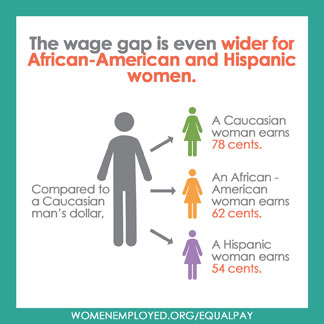Reposted from Huffington Post.
Today, July 16, 9to5 will join partner organizations to recognize African American Women’s Equal Pay Day. This day represents how far into 2014 African American women must work to earn what white men earned in 2013 alone.
While we have always recognized the pay gap discrepancies for women of color, today African American Women’s Equal Pay Day is acknowledged on its own.
Women of color are overrepresented in undervalued and underpaid occupations like child care, home health care, and the restaurant industry. Many working women are penalized financially for care giving because they lack access to basic policies like paid sick days and family leave.
The Rev. Harriet Bradley, a 9to5 member in Atlanta, Ga., knows first-hand about working in one of these undervalued fields as a home health worker.
“I quickly discovered that there was an attitude that my work was menial and the value of it minimal. We don’t tend to highly value the work that is traditionally done by women,” Bradley said. “In fact, we will pay someone more to take of our cars than we will pay them to take care of our children or elderly parents.”
The gender pay gap affects all women, but for African American women and Latinas, it is a chasm. Sixty-four cents — that’s how much African American women earn on average compared to every dollar earned by white men, the highest earners.
Women of color across the U.S. face a wage gap affected by both gender and race. An African American woman working full time, year-round, makes on average a whopping $18,650 less each year than a white man working full time, year-round.
Families and communities suffer as a result of the gender/race wage gap. In fact, 38 percent of families headed by African American women live in poverty.
When women are paid less than men, it hurts their families and the economy. Women lose hundreds of thousands of dollars over their careers. That means less money to pay for basic expenses like food and utilities, and achieve economic stability for their families. And since women make three-quarters of family purchasing decisions, it means less money is spent in our local communities and economy.
Women face a pay gap in nearly every occupation. From elementary and middle school teachers to computer programmers and restaurant servers, women are paid less than men in female-dominated, gender-balanced, and male-dominated occupations. Educational factors rarely make a difference, particularly for women of color. While education increases income overall, Black and Latina women earn less than their white peers, even when they have the same educational credentials.
There are many ways our country can recognize and value the work of African American women. We can raise the minimum wage, as women of color are over-represented in those lowest-paid jobs.
Congress can pass the Paycheck Fairness Act, which would strengthen current equal pay laws by allowing workers to discuss their wages without retribution, providing greater incentives to close the pay gap, and toughening the penalties for wage discrimination.
We need to build support for the Family and Medical Insurance Leave Act (FAMILY), to establish a program that allows working people to take paid time off to care for a new child, sick family member or their own illness.
And we need the Healthy Families Act, which would require more jobs to offer earned sick days. More than 80 percent of low wage workers don’t have access to a single paid sick day for themselves or their children. Working moms carry the brunt of financial distress when they need time to take care of a sick child, and are often at risk of losing employment when caring for an ill family member.
It’s time for this country to value the work of women of color. It’s time to offer equal pay for equal work.


